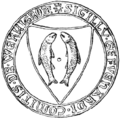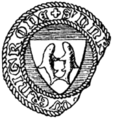Coat of arms of the city of Wernigerode
The coat of arms of Wernigerode is the official emblem of the city of Wernigerode in Saxony-Anhalt .
history
Wernigerode had a coat of arms in common law for centuries without this ever having been approved by a higher authority. An award certificate or the mention of one cannot be proven in the archives. When, after the political change in 1989, the municipal supervision of the state of Saxony-Anhalt checked the legality of the corporations bearing the coat of arms, the city of Wernigerode was called upon to bring its city coat of arms to a proper approval process. The coat of arms, which did not fully meet the requirements of the authorities, had to be corrected.
The redesign of the coat of arms as well as its scientific documentation for the purpose of the approval procedure by the state government were commissioned to the Magdeburg heraldist Jörg Mantzsch in 1995 in order to use a coat of arms corresponding to the specifications of the Ministry of the Interior and officially approved in the seal, if necessary on the flag of the city and in other use To carry national emblems of the place.
The oldest surviving representation of the coat of arms of Wernigerode is in the form of a seal on a certificate from 1309. However, it can be assumed that the coat of arms appears in the seal of the city shortly after the city charter was granted . The color scheme (red on silver or white) appears in the 16th century. The portcullis in the upper three-pass arch appears for the first time in a city seal from 1610.
The castle is not the image of the palace, but symbolizes the defensive strength of the city. The trout featured in the coat of arms today is borrowed from the coat of arms of the Counts of Wernigerode .
Johann Siebmacher defined the fish in the Wernigerode seal as "fish that is generally referred to as trout". This means that with regard to the trout indigenous to the region, the heraldic fish was interpreted as such 400 years ago.
At the end of the 19th and beginning of the 20th century, the heraldist Otto Hupp carried out research and research on the coats of arms and seals of numerous central German locations. As can be seen from his research, a trout was named in the blazon of the coat of arms. The city of Wernigerode decided to design the city arms according to the specifications of the Ministry of the Interior of Saxony-Anhalt. This was done with the coat of arms now in use by the heraldist Mantzsch in coordination with the State Main Archive of Saxony-Anhalt as the department and expert body of the Ministry of the Interior of the State Government. With the clear contouring of the fish, especially the addition of the adipose fin, the alleged fish should be clearly identifiable as trout. In all seals of the Counts of Wernigerode, however, it already showed the clear heraldic characteristics of a trout.
The following changes compared to the previously used coat of arms were made during the redesign:
- The wall with towers was widened.
- The castle was not shown floating, but grows out of the shield, ie touches the shield from the side.
- The tin towers have towering battlements and one breakthrough each.
- All openings are silver.
- The trout is contoured typical of the species according to naturalistic requirements.
- The cloverleaf gate is lowered. For this purpose, the radius of the outer arches was increased.
- In contrast to earlier representations, the roof of the central tower was left as pointed.
The traditional red and white colors have been retained.















